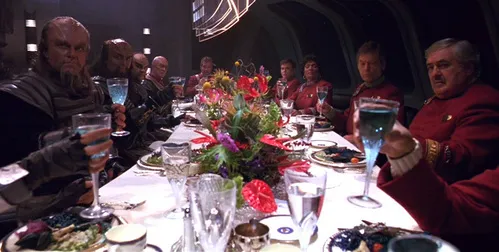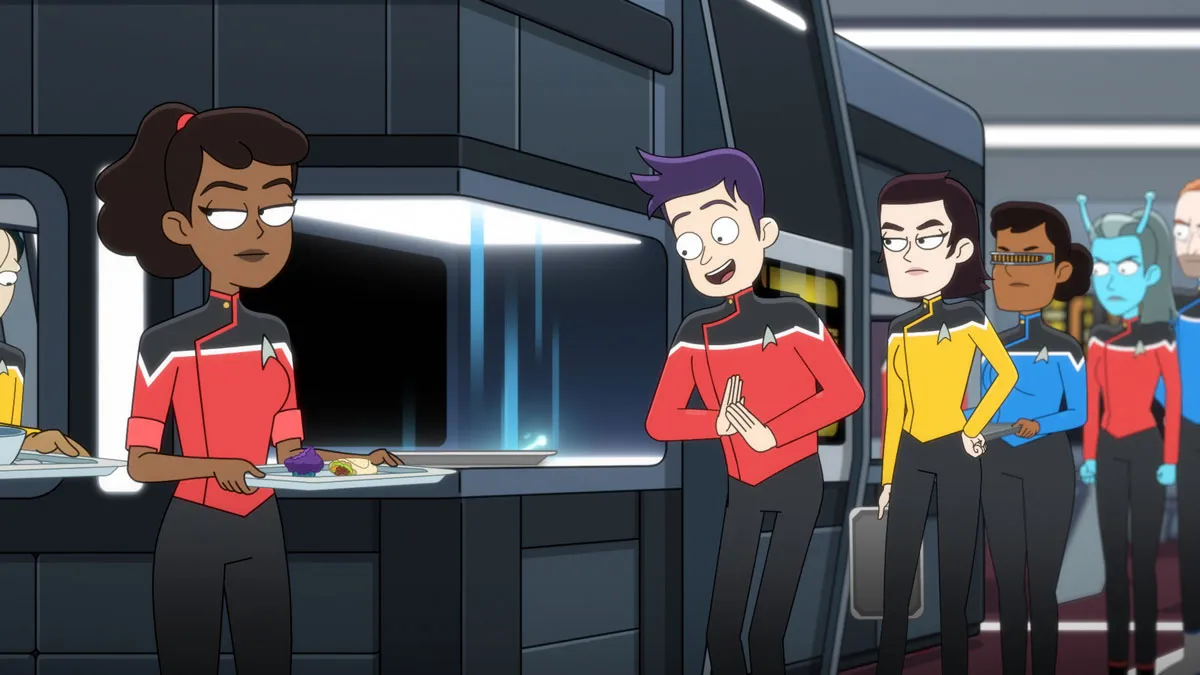FADE IN: How to Eat Gagh, Cheap Chicken, and Write a More Palatable Story
- braxtonrickert
- Oct 16, 2022
- 4 min read
Updated: Oct 17, 2022

Whether it is Science Fiction or Comedy or Murder Mystery, a commonly overlooked storytelling element is food.
Food has been a part of Star Trek since the very beginning (see the cubes of color in the picture above). After all, food is at the very core of the human experience - and so naturally would become part of Trek's very essence and writers have found numerous ways to include it in the various Trek stories.
In fact, Star Trek: Voyager introduced its very own chef character!

Neelix is a prime example of how food can be a reflection on the general morale of a crew. Food and the scenes around it allow the writers to find a lighter side to the characters and explore themes and emotions that can't happen on the bridge.

So why is eating and food featured so much in Star Trek, and in writing in general?

Fundamentally - it is something we all do to take in nutrients and create energy.
It's about the shared experience - coming together in a daily ritual of sorts. Or something shared that can bring two distant parties closer. (See slide show)
Food can summon up a variety of emotions:
There's Nostalgia. Like Worf wanting his mother to send him Rokeg Blood Pies.
Or Humor. Think of the replicator sending Ensign Boimler steamed bananas in Star Trek: Lower Decks. (The replicator sending hot bananas also happens in Star Trek: Discovery? Either Star Trek Engineering Corp is slipping, or someone at Paramount+ has an axe to grind with Chiquita.)
Hell, food can even become a great source of fear and confusion in the Star Trek Universe:

Eating is part of the everyday experience, and can be windows into our characters and tell us more about them than from a simple description. One of the fundamental rules in screenwriting is simple: Show, Don't Tell.
Food and eating is so elemental that it can fade into the background, and give you a good setting to reveal more about your character. That way you can hide your exposition as much as possible.
Maybe the food tells us if the character is staunched in tradition and of a more elegant air:
Or perhaps a food can give a character (or by extension a series) a thesis - a call to its themes, such as Captain Janeway in Star Trek: Voyager:

In his book, FADE IN:THE MAKING OF STAR TREK: INSURRECTION, Michael Piller also touches upon food and how it can be used to show the state of a character's emotional journey or thematic state.
In the film, Michael intended one of Captain Picard's arcs to be how cluttered his life has become, and caught up with so much detail/duty that he cannot appreciate or pursue any more meaningful goals in his life.
In fact, there is a scene at the beginning of the movie that was written to signify this. Picard is in his quarters, about to eat lunch. He has replicated tea, a salad, and is working off a PADD. He is so busy multitasking, that he ends up spilling the lunch all over himself.
The scene ended up being cut from the theatrical version of the film, but you can watch it here:
To some, it might seem humorous and clumsy, but it is more of a man so caught up in everything that he cannot stop to take in any small moments - a journey that resolves when he is able to slow things down on the Ba'Ku planet and finally live in the moment.
Here we can see how food can be a tool for writers to signify humor, set up how a protagonist is overwhelmed and caught up in life, as well as lay down some exposition between two different characters.
A small scene, but food in a script can accomplish a lot.
And who knew Riker and Janeway were so similar...

Similarly, food became a great ritual in the making of this ninth Star Trek film. As Michael writes in his book, about returning to the Star Trek franchise to write the film:
"Rick [Berman] and I settled back into our old collaborative rhythms. As we always had when we were creating a new television show, we met every day for lunch. I would usually order a cold chicken plate from the cafeteria which became known as "Mike's Cheap Chicken," because it was better than the more expensive chicken plate from the dining room. Rick would often have cottage cheese and fruit. He had a continuing struggle with his weight, the only sign I ever saw of the overwhelming stress from producing two TV series and a feature film simultaneously." (Piller, 14)
This ritual becomes a focal point for Michael in how he tells the story of Star Trek: Insurrection's development. As we read along, this simple meal of cheese and chicken allows Michael to give us insight on the relationship between a producer and writer - what their interplay is like as they return back to the same meal with differing interactions.
Writers, don't forget to utilize food in your scenes. Use it to tell your stories and pass along information. It's not just set dressing.
Food can be an art - a story unto itself. A way into the human condition. A beat of normality where the same meal can have very different contexts, like Michael and his Cheap Chicken lunches with Rick Berman. A bit of humor - of sadness - of connection.
Next time you watch something, see how food is being used in the scene. Is it passive? Or is it helping tell the story and bring the audience closer to the characters?

Let me know what your favorite Trek Foods are below!
For more on Mike's Cheap Chicken, check out FADE IN: THE MAKING OF STAR TREK: INSURRECTION by Michael Piller. You can purchase it directly on this site!
Until next time...
LLAP!
- Braxton







Comments